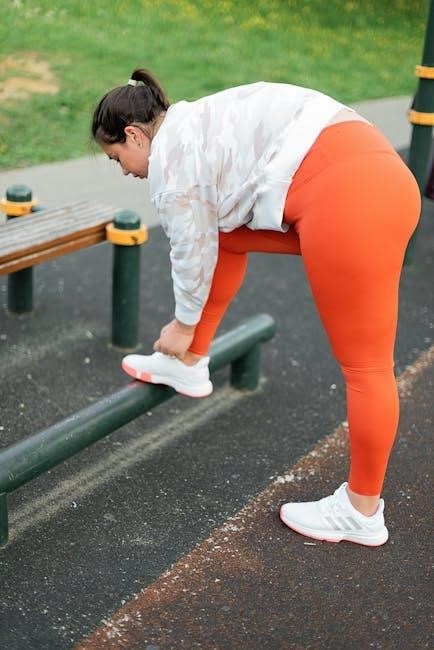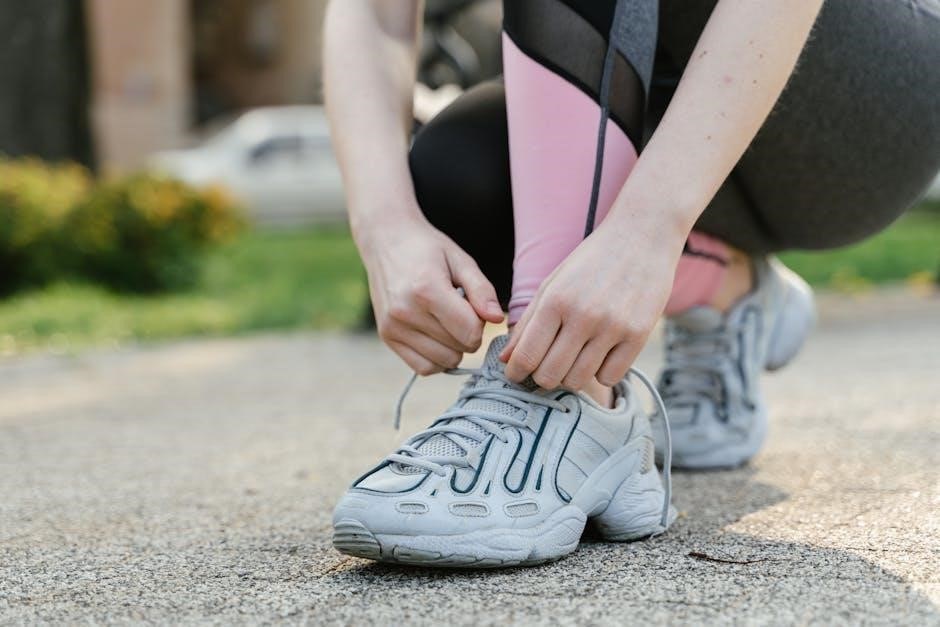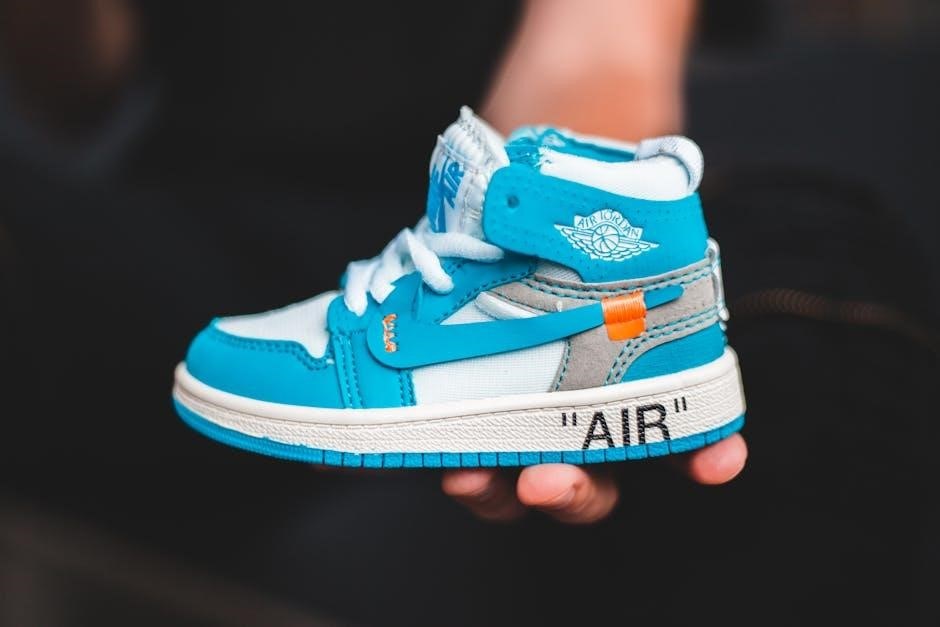
shoelace size guide
While often overlooked, shoelace size significantly impacts comfort and security. This guide helps you find the perfect fit, ensuring optimal performance and style for your footwear.
Understanding the Importance of Proper Shoelace Fit
Proper shoelace fit is essential for both comfort and functionality. Ill-fitting laces can lead to discomfort, blisters, or even foot fatigue. On the other hand, laces that are too tight may restrict movement, while those that are too loose can cause tripping hazards or difficulty keeping shoes secure. A well-fitted shoelace ensures your foot stays snug inside the shoe, providing the necessary support and stability, especially during physical activities. Additionally, the right fit helps maintain the shoe’s structure, preventing excessive wear and tear. Whether for sneakers, boots, or dress shoes, understanding how to choose the correct length and width of shoelaces is key to achieving the perfect balance between style and comfort.

Key Considerations for Choosing the Right Shoelace Size
Measure current laces, count eyelets, and consider shoe type to determine ideal length. Material and style should match footwear needs for durability and aesthetics.
The Role of Eyelet Count in Determining Shoelace Length
The number of eyelets on a shoe is a critical factor in choosing the right shoelace length. Eyelets are the small holes on either side of the shoe where the laces pass through. Generally, shoes with more eyelets require longer laces to ensure proper tightening and comfort. For example, shoes with 3-4 eyelets typically need laces around 36 inches, while those with 9-11 eyelets may require laces up to 72 inches or more. Counting the eyelets provides a reliable starting point for selecting the appropriate lace length, ensuring a secure and comfortable fit.
- 3-4 eyelets: 36 inches
- 5-6 eyelets: 40-45 inches
- 7-8 eyelets: 45-54 inches
- 9-11 eyelets: 60-72 inches
This method ensures your laces are neither too short nor too long, providing optimal functionality and style.
How Shoe Type Affects Shoelace Size Requirements
Different shoe types require varying shoelace lengths due to their unique designs and functionalities. Sneakers and athletic shoes often have more eyelets, necessitating longer laces for secure tightening. Boots, especially taller ones, may require even longer laces to accommodate their height and multiple eyelets. Dress shoes, with fewer eyelets, typically need shorter, thinner laces for a sleek appearance. The number of eyelets and the shoe’s intended use are key factors in determining the appropriate lace length. For example, hiking boots may need durable, longer laces, while running shoes might prioritize lightweight, shorter ones. Understanding your shoe type helps ensure the right fit and performance.
Shoelace Length vs. Width: What You Need to Know
Shoelace length and width are critical factors in ensuring proper fit and functionality. Length is determined by the number of eyelets and the shoe type, with longer laces needed for shoes with more eyelets, such as boots or sneakers. Width, on the other hand, affects comfort and durability, with wider laces providing better support for heavier or sturdier footwear. Narrow laces are ideal for dress shoes or lightweight sneakers. Measuring your current laces or consulting a sizing chart can help you determine the perfect dimensions. Balancing both length and width ensures your shoes stay secure, comfortable, and visually appealing.

Measuring Your Shoelaces for the Perfect Fit
Measuring your shoelaces ensures a perfect fit. Remove the laces, measure their length and width, and compare them to a sizing chart for accuracy.
Step-by-Step Guide to Measuring Your Current Shoelaces
To ensure the perfect fit, follow these steps to measure your shoelaces accurately:
- Remove the laces from your shoe and lay them flat on a surface.
- Measure the total length of the lace from one tip to the other using a ruler or measuring tape.
- Record the width of the lace to ensure compatibility with your shoe’s eyelets.
- Compare your measurements to a shoelace sizing chart for accurate size matching.
Accurate measurements ensure your new laces provide the right fit, comfort, and security for your footwear;
How to Use a Shoelace Sizing Chart for Accuracy
Using a shoelace sizing chart is a straightforward process that ensures you select the correct lace length for your footwear. Start by identifying the number of eyelets on your shoe, as this is a key factor in determining the required lace length. Next, locate your shoe type (sneakers, boots, etc.) on the chart, as different styles have specific sizing standards. Align the number of eyelets with the corresponding lace length recommendation. If unsure, measure your current laces and compare the length to the chart. This method provides a precise match, ensuring your laces are neither too short nor too long for optimal comfort and security.

Shoelace Size Charts and Recommendations
Shoelace size charts offer a detailed guide to selecting the perfect lace length based on your shoe type and eyelet count, ensuring a secure and comfortable fit.
Standard Shoelace Lengths Based on Eyelet Count

Shoelace length is often determined by the number of eyelets on your shoe. Shoes with 3-4 eyelets typically require laces around 36 inches long, while those with 5-7 eyelets need laces measuring approximately 45 inches. For shoes with 8-10 eyelets, a 54-inch lace is standard, and for 11 or more eyelets, 63-inch laces are recommended. These lengths ensure proper lacing without excess material, providing a secure fit. However, specific shoe types or personal preferences may require adjustments. Always measure your current laces or consult a sizing chart for accuracy. Proper fit ensures comfort and prevents laces from coming undone during wear.
Recommended Lace Lengths for Different Footwear Types
Different footwear types require specific lace lengths for optimal fit and performance. Sneakers typically use laces ranging from 45 to 54 inches, depending on the shoe’s design and eyelet count. Boots, especially taller ones, often need longer laces, typically between 63 to 72 inches, to accommodate their height and multiple eyelets. Dress shoes, with fewer eyelets, usually require shorter laces, around 36 to 45 inches. Athletic shoes may vary, but 45 to 54 inches is standard. These recommendations ensure proper lacing without excess material, balancing comfort and style. Always consider the shoe’s specific design and your personal preference when choosing lace length.

Specialized Shoelace Needs
Specialized shoelaces cater to specific footwear types, ensuring optimal fit and functionality. Sneakers often require shorter, durable laces, while boots need longer, heavier-duty options for secure lacing.
Shoelace Sizes for Sneakers and Athletic Shoes
For sneakers and athletic shoes, the ideal shoelace length is typically determined by the number of eyelets, which usually ranges between 6 to 8 pairs. A general rule of thumb is to use laces that are 45-50 inches long for most sneakers, as this provides adequate length for secure tying without excess. However, specific athletic shoes may require shorter or longer laces depending on their design and intended use. For example, running shoes often benefit from slightly shorter laces to prevent them from coming undone during intense activity. Additionally, the material and durability of the laces should match the demands of the shoe, ensuring they can withstand frequent use. Proper fit is crucial for both comfort and performance.
Shoelace Sizes for Boots and Dress Shoes
Boots and dress shoes often require longer shoelaces due to their higher number of eyelets, typically ranging from 6 to 12 pairs. For boots, a lace length of 60-72 inches is common, ensuring a secure fit around the ankle and shaft. Dress shoes, while similar, may need slightly shorter laces, around 50-65 inches, depending on the shoe’s height and design. The material and width of the laces should complement the shoe’s style, with dress shoes favoring slimmer, more elegant options and boots often using thicker, more durable laces. Proper sizing ensures comfort, prevents excessive slack, and maintains the shoe’s aesthetic appeal. Choosing the right length is essential for both functionality and style.

Additional Tips for Selecting the Right Shoelaces
Consider the shoe’s material, your activity level, and personal style. Opt for durable materials like nylon or polyester for longevity and comfort in various conditions.
How to Choose the Right Material for Your Shoelaces
Selecting the right material for your shoelaces depends on durability, comfort, and style. Nylon and polyester are popular choices for their strength and resistance to wear. Waxed laces offer a sleek appearance and smooth tying experience, while cotton laces provide softness and breathability. For athletic shoes, consider moisture-resistant materials like elastic or performance-specific laces. If you prefer a vintage look, canvas or hemp laces are great options. Ultimately, the material should align with your lifestyle, footwear type, and personal preferences to ensure optimal comfort and functionality.
The Impact of Color and Style on Shoelace Choice
The color and style of your shoelaces can significantly enhance the aesthetic and functionality of your footwear. Bold colors like red or blue can add a vibrant touch, while neutral tones such as black or white offer versatility. Patterned laces, like polka dots or stripes, can add a unique flair, making your shoes stand out. Metallic or glow-in-the-dark options are perfect for those who want a futuristic or eye-catching look. Additionally, slim or thick laces can complement the design of your shoes, depending on their style. Ultimately, the right color and style can transform your footwear, blending practicality with personal expression to create a look that reflects your individuality.